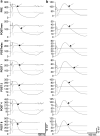Use of transcranial magnetic stimulation to assess relaxation rates in unfatigued and fatigued knee-extensor muscles
- PMID: 33140192
- PMCID: PMC7884370
- DOI: 10.1007/s00221-020-05921-9
Use of transcranial magnetic stimulation to assess relaxation rates in unfatigued and fatigued knee-extensor muscles
Abstract
We examined whether transcranial magnetic stimulation (TMS) delivered to the motor cortex allows assessment of muscle relaxation rates in unfatigued and fatigued knee extensors (KE). We assessed the ability of this technique to measure time course of fatigue-induced changes in muscle relaxation rate and compared relaxation rate from resting twitches evoked by femoral nerve stimulation. Twelve healthy men performed maximal voluntary isometric contractions (MVC) twice before (PRE) and once at the end of a 2-min KE MVC and five more times within 8 min during recovery. Relative (intraclass correlation coefficient; ICC2,1) and absolute (repeatability coefficient) reliability and variability (coefficient of variation) were assessed. Time course of fatigue-induced changes in muscle relaxation rate was tested with generalized estimating equations. In unfatigued KE, peak relaxation rate coefficient of variation and repeatability coefficient were similar for both techniques. Mean (95% CI) ICC2,1 for peak relaxation rates were 0.933 (0.724-0.982) and 0.889 (0.603-0.968) for TMS and femoral nerve stimulation, respectively. TMS-induced normalized muscle relaxation rate was - 11.5 ± 2.5 s-1 at PRE, decreased to - 6.9 ± 1.2 s-1 (- 37 ± 17%, P < 0.001), and recovered by 2 min post-exercise. Normalized peak relaxation rate for resting twitch did not show a fatigue-induced change. During fatiguing KE exercise, the change in muscle relaxation rate as determined by the two techniques was different. TMS provides reliable values of muscle relaxation rates. Furthermore, it is sufficiently sensitive and more appropriate than the resting twitch evoked by femoral nerve stimulation to reveal fatigue-induced changes in KE.
Keywords: Fatigue; Knee extensors; Muscle relaxation rate; Transcranial magnetic stimulation.
Conflict of interest statement
All authors declared no competing interests.
Figures




Similar articles
-
Reliability of relaxation properties of knee-extensor muscles induced by transcranial magnetic stimulation.Neurosci Lett. 2022 Jun 21;782:136694. doi: 10.1016/j.neulet.2022.136694. Epub 2022 May 21. Neurosci Lett. 2022. PMID: 35609711
-
Skeletal muscle fiber type and TMS-induced muscle relaxation in unfatigued and fatigued knee-extensor muscles.Am J Physiol Regul Integr Comp Physiol. 2024 May 1;326(5):R438-R447. doi: 10.1152/ajpregu.00174.2023. Epub 2024 Mar 25. Am J Physiol Regul Integr Comp Physiol. 2024. PMID: 38525536
-
Use of motor cortex stimulation to measure simultaneously the changes in dynamic muscle properties and voluntary activation in human muscles.J Appl Physiol (1985). 2007 May;102(5):1756-66. doi: 10.1152/japplphysiol.00962.2006. Epub 2007 Jan 11. J Appl Physiol (1985). 2007. PMID: 17218428
-
Transcranial magnetic stimulation and human muscle fatigue.Muscle Nerve. 2001 Jan;24(1):18-29. doi: 10.1002/1097-4598(200101)24:1<18::aid-mus2>3.0.co;2-d. Muscle Nerve. 2001. PMID: 11150962 Review.
-
Stimulation of the motor cortex and corticospinal tract to assess human muscle fatigue.Neuroscience. 2013 Feb 12;231:384-99. doi: 10.1016/j.neuroscience.2012.10.058. Epub 2012 Nov 3. Neuroscience. 2013. PMID: 23131709 Review.
Cited by
-
Neural and muscular contributions to the age-related loss in power of the knee extensors in men and women.bioRxiv [Preprint]. 2023 Oct 28:2023.10.24.563851. doi: 10.1101/2023.10.24.563851. bioRxiv. 2023. Update in: J Appl Physiol (1985). 2024 Oct 1;137(4):1021-1040. doi: 10.1152/japplphysiol.00773.2023. PMID: 37961177 Free PMC article. Updated. Preprint.
-
Transcranial magnetic stimulation in the assessment of acupuncture effect on exercise-induced fatigue.Brain Behav. 2024 Jun;14(6):e3575. doi: 10.1002/brb3.3575. Brain Behav. 2024. PMID: 38867451 Free PMC article. Clinical Trial.
-
Effects of combined treatment with transcranial and peripheral electromagnetic stimulation on performance and pain recovery from delayed onset muscle soreness induced by eccentric exercise in young athletes. A randomized clinical trial.Front Physiol. 2023 Oct 11;14:1267315. doi: 10.3389/fphys.2023.1267315. eCollection 2023. Front Physiol. 2023. PMID: 37900951 Free PMC article.
-
Influence of combined transcranial and peripheral electromagnetic stimulation on the autonomous nerve system on delayed onset muscle soreness in young athletes: a randomized clinical trial.J Transl Med. 2025 Mar 10;23(1):306. doi: 10.1186/s12967-025-06238-3. J Transl Med. 2025. PMID: 40065317 Free PMC article. Clinical Trial.
-
Neural and muscular contributions to the age-related differences in peak power of the knee extensors in men and women.J Appl Physiol (1985). 2024 Oct 1;137(4):1021-1040. doi: 10.1152/japplphysiol.00773.2023. Epub 2024 Aug 29. J Appl Physiol (1985). 2024. PMID: 39205638 Free PMC article.

